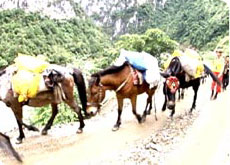Source: CCTV.com
08-02-2006 19:08

For thousands of years, horse caravans have been traversing probably the highest passes in the world, negotiating the most treacherous weather conditions, and trail-blazed a path known as the route of Tea and Horses. But nowadays, because modern roads are built so widely, the only place you can find horse caravans, the last horse caravans, is at Bing Zhongluo, which is at the northern tip of Nujiang Valley.
Bing Zhongluo sits on the border of Yunnan and Tibet where Nujiang twists into several sharp turns and creates small pieces of fertile land along its banks.
For centuries, it has been the safe haven for Nu, Tibet, Lisu and Dulong people.
Bing zhongluo is the only passage connecting Yunnan and Tibet on the south route of the ancient tea and horse trade route.
On the long list of Nujiang Valley's credentials, being a museum of bridges is one of them. We have encountered numerous bridges along our trip from Liuku to Bing Zhongluo, so I have to take this one. And across this bridge, it can take me to Biluo Snow Mountain.
Everyday, there are three mini-buses, not minibuses, just a kind of truck. Going from Bing Zhongluo to Qiu Natong, a small village nears the border of Yunnan and Tibet.
It costs six Yuan from Bing Zhongluo township to Qiu na tong, a small village where I might bump into Tibetan horse caravans according to my fellow passengers.
Just as what I was told, a caravan team is trodding on the way from Bingzhongluo to Qiu na tong.
These are the real horse caravans coming from Tibet, a small village named Chalong. It's right on the other side of the border of Yunnan and Tibet.
In olden days, Tibetans routinely operated mule and horse caravans on arduous long journeys between to Lhasa, and beyond, to Nepal, Bhutan, Sikkim and India.
With the tea-trade bustling, the caravan routes became vital arteries for cultural, economic and religious exchange between Tibet and South Asia.

